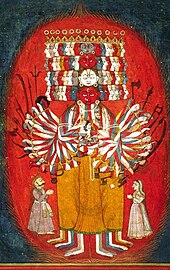Independence movement[edit]
At a time when Indian nationalists were seeking an indigenous basis for social and political action, Bhagavad Gita provided them with a rationale for their activism and fight against injustice.[106] Among nationalists, notable commentaries were written by Bal Gangadhar Tilak and Mahatma Gandhi, who used the text to help inspire the Indian independence movement.[note 8][note 9] Tilak wrote his commentary Shrimadh Bhagvad Gita Rahasya while in jail during the period 1910–1911 serving a six-year sentence imposed by the British colonial government in India for sedition.[107] While noting that the Gita teaches possible paths to liberation, his commentary places most emphasis on Karma yoga.[108] No book was more central to Gandhi's life and thought than the Bhagavad Gita, which he referred to as his "spiritual dictionary".[109] During his stay in Yeravda jail in 1929,[109] Gandhi wrote a commentary on the Bhagavad Gita in Gujarati. The Gujarati manuscript was translated into English by Mahadev Desai, who provided an additional introduction and commentary. It was published with a foreword by Gandhi in 1946. [110][111][note 10] Mahatma Gandhi expressed his love for the Gita in these words:
Hindu revivalism[edit]
Although Vivekananda did not write any commentaries on the Bhagavad Gita, his works contained numerous references to the Gita, such as his lectures on the four yogas – Bhakti, Gyaana, Karma, and Raja.[114] Through the message of the Gita, Vivekananda sought to energise the people of India to claim their own dormant but strong identity.[115] Bankim Chandra Chattopadhyay thought that the answer to the problems that beset Hindu society was a revival of Hinduism in its purity, which lay in the reinterpretation of Bhagavad Gita for a new India.[116] Aurobindo saw Bhagavad Gita as a "scripture of the future religion" and suggested that Hinduism had acquired a much wider relevance through the Gita.[117]Sivananda called Bhagavad Gita "the most precious jewel of Hindu literature" and suggested its introduction into the curriculum of Indian schools and colleges.[118] In the lectures Chinmayananda gave, on tours undertaken to revive the moral and spiritual values of the Hindus, he borrowed the concept of Gyaana yajna, or the worship to invoke divine wisdom, from the Gita.[119] He viewed the Gita as an universal scripture to turn a person from a state of agitation and confusion to a state of complete vision, inner contentment, and dynamic action. Teachings of International Society for Krishna Consciousness (ISKCON), a Gaudiya Vaishnava religious organisation which spread rapidly in North America in the 1970s and 1980s, are based on a translation of the Gita called Bhagavad-Gītā As It Is by A.C. Bhaktivedanta Swami Prabhupada.[120] These teachings are also illustrated in the dioramas of Bhagavad-gita Museum in Los Angeles, California.[121]
Other modern commentaries[edit]
Among notable modern commentators of the Bhagavad Gita are Bal Gangadhar Tilak, Vinoba Bhave, Mohandas Karamchand Gandhi, Sri Aurobindo, Sarvepalli Radhakrishnan, Chinmayananda, etc. Chinmayananda took a syncretistic approach to interpret the text of the Gita.[122][123]
Paramahansa Yogananda's two volume commentary on the Bhagavad Gita, called God Talks With Arjuna: The Bhagavad Gita, was released 1995.[124]
Eknath Easwaran has also written a commentary on the Bhagavad Gita. It examines the applicability of the principles of Gita to the problems of modern life.[125]
The version by A. C. Bhaktivedanta Swami Prabhupāda, entitled Bhagavad-gītā As It Is, is "by far the most widely distributed of all English Gita translations" due to ISKCONefforts.[126] For each verse, he gives the verse in the Sanskrit Devanagari script, followed by a roman transliteration, a gloss for each word, and then a translation and commentary.[126] Its publisher, the Bhaktivedanta Book Trust, estimates sales at twenty-three million copies, a figure which includes the original English edition and secondary translations into fifty-six other languages.[126]
Bhagavad Gita – The song of God[127] written by Swami Mukundananda.
Other notable commentators include Jeaneane Fowler, Ithamar Theodor, Swami Parthasarathy, and Sadhu Vasvani.[128][129] In 1966, Maharishi Mahesh Yogi published a partial translation.[130]
